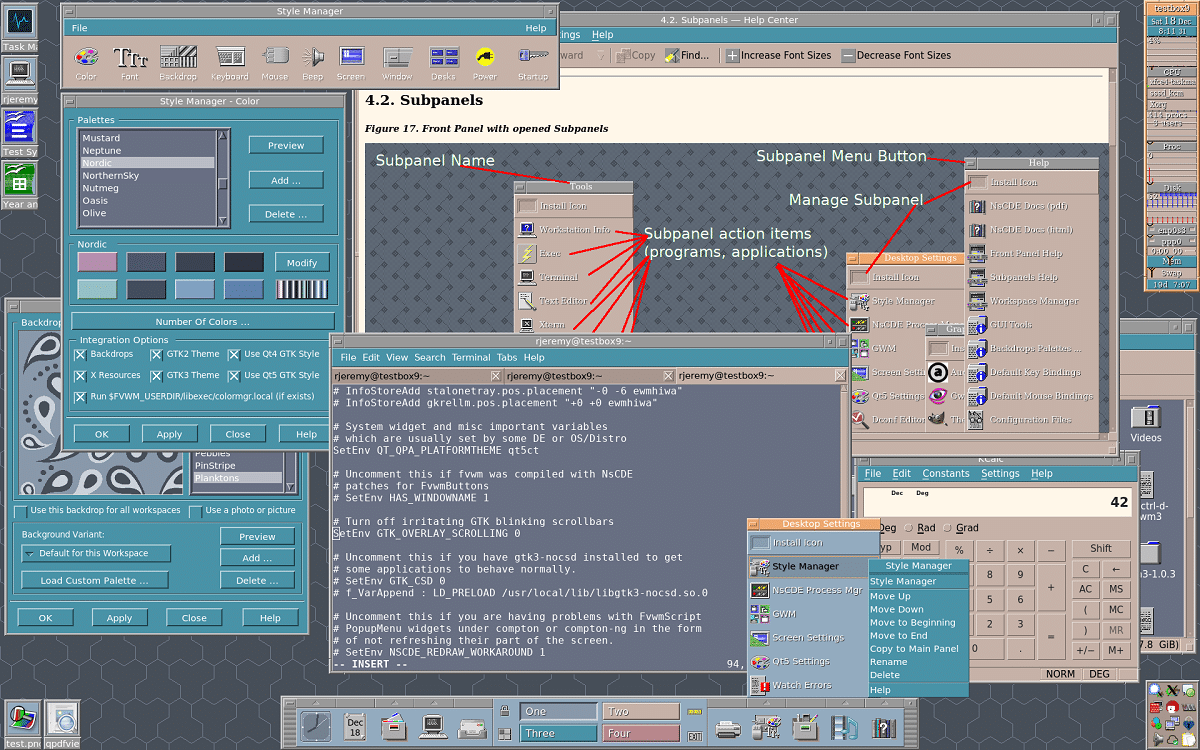
NsCDE is a retro, but powerful desktop environment that resembles CDE.
After 11 months of development, the release of the new version of the project nsCDE 2.3 (Not so Common Desktop Environment)
For those who are unaware of NsCDE, they should know that this is a project that develops a desktop environment with a retro interface CDE (Common Desktop Environment) style, adapted for use on modern Unix and Linux-like systems.
NsCDE can be considered as a FVWM theme heavyweight on steroids, but combined with a couple of other free software components and custom FVWM applications and lots of configuration, NsCDE can be considered a lightweight hybrid desktop environment.
NsCDE mimics CDE, the well-known Common Desktop Environment of many UNIX systems commercials of the nineties. Supports backgrounds and palettes with color sets and has a theme generator for Xt, Xaw, Motif, GTK2 and GTK3.
Main novelties of NsCDE 2.3
In this newly released version of NsCDE 2.3 Many fixes and improvements have been implemented, as well as some new functions and of which it stands out Qt6 integration support, as well as optional internal support for using the Picom Composite Server (a fork of Compton).
Another change that stands out, is that the font and color styles manager has been redesigned and has been moved to a separate dialog, plus the ability to reload the theme without restarting the FVWM window manager has been added.
In addition to this, we can also find the support for using CSS themes from Thunderbird 102+ and Firefox 113+, as well as implemented the ability to process the gsetting org.gnome.desktop.interface parameter when setting color schemes.
Of the other changes that stand out from this new version:
- Added support for the Xscreensaver 6.X screensaver.
- X11 resources optimized for older applications.
- Fixed issues with GTK3 themes.
- Initial front panel location fix instead of a workaround
- More Missing Icons in XDG Icons Theme
- GTK3 theme fix: treat nasty headerbar as a toolbar
- Initial setup: add detailed integration questions, Qt6 compatibility
- Front panel clock: triangular hour and minute hands to match the original
- GWMPager as popup window on workspace switch in non-page mode
- Fixed some easy to make accidental keyboard shortcut calls
How to install NsCDE on Linux?
for those who are interested in being able to install this new version, they can do this by downloading and installing the compiled packages that are offered from the NsCDE repository.
For example, for those who are users of Debian, Ubuntu or any other distribution Based on these, the package to download is the following:
wget https://github.com/NsCDE/NsCDE/releases/download/2.3/nscde_2.3-3_amd64.deb
While ARM version:
wget https://github.com/NsCDE/NsCDE/releases/download/2.3/nscde_2.3-3_arm64.deb
Now We are going to install the necessary dependencies typing:
sudo apt update sudo apt dist-upgrade sudo apt install -y ksh xutils/x11-utils xdotool imagemagick \ xscreensaver x11-xserver-utils python3-yaml python3-pyqt5 \ qt5ct qt5-style-plugins stalonetray xterm python3 \ python3-xdg libstroke0 xsettingsd fvwm fvwm-icons \ libfile-mimeinfo-perl gkrellm rofi xclip libx11-dev \ libxext-dev libxpm-dev gettext build-essential xinit
And we proceed to install the package with:
sudo apt install ./nscde_2.3-3_amd64.deb
Now for the case of those who are users of Fedora or any other derivative of this, the package that must be downloaded is the following:
wget https://github.com/NsCDE/NsCDE/releases/download/2.3/NsCDE-2.3-3.fc38.x86_64.rpm
And install the dependencies necessary with:
sudo dnf update sudo dnf install -y ksh xorg-x11-utils xdotool ImageMagick xscreensaver \ python3-pyyaml python3-qt5 qt5ct qt5-styleplugins \ stalonetray xterm pyhon3 pyhon3-pyxdg libstroke xsettingsd \ fvwm perl-File-MimeInfo gkrellm rofi xclip
And to install the environment, you just have to run:
sudo rpm -i NsCDE-2.3-3.fc38.x86_64.rpm
Now in the case of OpenSUSE Leaf/Tumbleweed/GeckoLinux users, the package for your system is as follows:
wget https://github.com/NsCDE/NsCDE/releases/download/2.3/NsCDE-2.3-3.suse.x86_64.rpm
The dependencies to install are:
sudo zypper ref sudo zypper up sudo zypper in ksh-93uv xorg xdotool ImageMagick xscreensaver \ python3-pyyaml python3-PyQt5 qt5ct libqt5-styleplugins \ stalonetray xterm pyhon3 libstroke xsettingsd fvwm2 \ perl-File-MimeInfo gkrellm rofi xclip
And we proceed to install the environment with:
sudo rpm -i NsCDE-2.3-3.fc38.x86_64.rpm
Finally for those who are users of Arch Linux or any other derivative For this, they just have to have the AUR repository enabled and type:
yay -S nscde
It seems to me that sudo 'apt install ./nscde_2.3-3_amd64.deb' won't install the package, 'sudo dpkg -i ./nscde_2.3-3_amd64.deb' will.
Both are correct, when apt is used, it will install the package as long as all the dependencies are present.